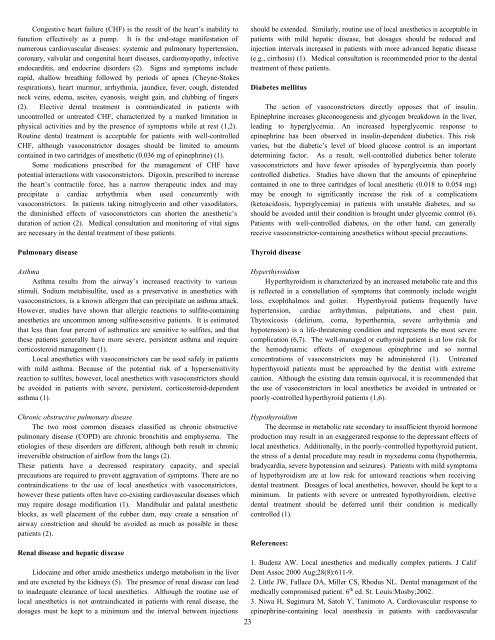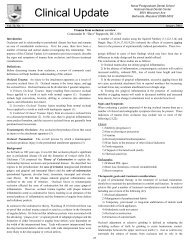Local anesthetics Part III
Local anesthetics Part III
Local anesthetics Part III
Create successful ePaper yourself
Turn your PDF publications into a flip-book with our unique Google optimized e-Paper software.
Congestive heart failure (CHF) is the result of the heart’s inability tofunction effectively as a pump. It is the end-stage manifestation ofnumerous cardiovascular diseases: systemic and pulmonary hypertension,coronary, valvular and congenital heart diseases, cardiomyopathy, infectiveendocarditis, and endocrine disorders (2). Signs and symptoms includerapid, shallow breathing followed by periods of apnea (Cheyne-Stokesrespirations), heart murmur, arrhythmia, jaundice, fever, cough, distendedneck veins, edema, ascites, cyanosis, weight gain, and clubbing of fingers(2). Elective dental treatment is contraindicated in patients withuncontrolled or untreated CHF, characterized by a marked limitation inphysical activities and by the presence of symptoms while at rest (1,2).Routine dental treatment is acceptable for patients with well-controlledCHF, although vasoconstrictor dosages should be limited to amountscontained in two cartridges of anesthetic (0.036 mg of epinephrine) (1).Some medications prescribed for the management of CHF havepotential interactions with vasoconstrictors. Digoxin, prescribed to increasethe heart’s contractile force, has a narrow therapeutic index and mayprecipitate a cardiac arrhythmia when used concurrently withvasoconstrictors. In patients taking nitroglycerin and other vasodilators,the diminished effects of vasoconstrictors can shorten the anesthetic’sduration of action (2). Medical consultation and monitoring of vital signsare necessary in the dental treatment of these patients.Pulmonary diseaseAsthmaAsthma results from the airway’s increased reactivity to variousstimuli. Sodium metabisulfite, used as a preservative in <strong>anesthetics</strong> withvasoconstrictors, is a known allergen that can precipitate an asthma attack.However, studies have shown that allergic reactions to sulfite-containing<strong>anesthetics</strong> are uncommon among sulfite-sensitive patients. It is estimatedthat less than four percent of asthmatics are sensitive to sulfites, and thatthese patients generally have more severe, persistent asthma and requirecorticosteroid management (1).<strong>Local</strong> <strong>anesthetics</strong> with vasoconstrictors can be used safely in patientswith mild asthma. Because of the potential risk of a hypersensitivityreaction to sulfites, however, local <strong>anesthetics</strong> with vasoconstrictors shouldbe avoided in patients with severe, persistent, corticosteroid-dependentasthma (1).should be extended. Similarly, routine use of local <strong>anesthetics</strong> is acceptable inpatients with mild hepatic disease, but dosages should be reduced andinjection intervals increased in patients with more advanced hepatic disease(e.g., cirrhosis) (1). Medical consultation is recommended prior to the dentaltreatment of these patients.Diabetes mellitusThe action of vasoconstrictors directly opposes that of insulin.Epinephrine increases gluconeogenesis and glycogen breakdown in the liver,leading to hyperglycemia. An increased hyperglycemic response toepinephrine has been observed in insulin-dependent diabetics. This riskvaries, but the diabetic’s level of blood glucose control is an importantdetermining factor. As a result, well-controlled diabetics better toleratevasoconstrictors and have fewer episodes of hyperglycemia than poorlycontrolled diabetics. Studies have shown that the amounts of epinephrinecontained in one to three cartridges of local anesthetic (0.018 to 0.054 mg)may be enough to significantly increase the risk of a complications(ketoacidosis, hyperglycemia) in patients with unstable diabetes, and soshould be avoided until their condition is brought under glycemic control (6).Patients with well-controlled diabetes, on the other hand, can generallyreceive vasoconstrictor-containing <strong>anesthetics</strong> without special precautions.Thyroid diseaseHyperthyroidismHyperthyroidism is characterized by an increased metabolic rate and thisis reflected in a constellation of symptoms that commonly include weightloss, exophthalmos and goiter. Hyperthyroid patients frequently havehypertension, cardiac arrhythmias, palpitations, and chest pain.Thytoxicosis (delirium, coma, hyperthermia, severe arrhythmia andhypotension) is a life-threatening condition and represents the most severecomplication (6,7). The well-managed or euthyroid patient is at low risk forthe hemodynamic effects of exogenous epinephrine and so normalconcentrations of vasoconstrictors may be administered (1). Untreatedhyperthyroid patients must be approached by the dentist with extremecaution. Although the existing data remain equivocal, it is recommended thatthe use of vasoconstrictors in local <strong>anesthetics</strong> be avoided in untreated orpoorly-controlled hyperthyroid patients (1,6).Chronic obstructive pulmonary diseaseThe two most common diseases classified as chronic obstructivepulmonary disease (COPD) are chronic bronchitis and emphysema. Theetiologies of these disorders are different, although both result in chronicirreversible obstruction of airflow from the lungs (2).These patients have a decreased respiratory capacity, and specialprecautions are required to prevent aggravation of symptoms. There are nocontraindications to the use of local <strong>anesthetics</strong> with vasoconstrictors,however these patients often have co-existing cardiovascular diseases whichmay require dosage modification (1). Mandibular and palatal anestheticblocks, as well placement of the rubber dam, may create a sensation ofairway constriction and should be avoided as much as possible in thesepatients (2).Renal disease and hepatic diseaseLidocaine and other amide <strong>anesthetics</strong> undergo metabolism in the liverand are excreted by the kidneys (5). The presence of renal disease can leadto inadequate clearance of local <strong>anesthetics</strong>. Although the routine use oflocal <strong>anesthetics</strong> is not contraindicated in patients with renal disease, thedosages must be kept to a minimum and the interval between injections23HypothyroidismThe decrease in metabolic rate secondary to insufficient thyroid hormoneproduction may result in an exaggerated response to the depressant effects oflocal <strong>anesthetics</strong>. Additionally, in the poorly-controlled hypothyroid patient,the stress of a dental procedure may result in myxedema coma (hypothermia,bradycardia, severe hypotension and seizures). Patients with mild symptomsof hypothyroidism are at low risk for untoward reactions when receivingdental treatment. Dosages of local <strong>anesthetics</strong>, however, should be kept to aminimum. In patients with severe or untreated hypothyroidism, electivedental treatment should be deferred until their condition is medicallycontrolled (1).References:1. Budenz AW. <strong>Local</strong> <strong>anesthetics</strong> and medically complex patients. J CalifDent Assoc 2000 Aug;28(8):611-9.2. Little JW, Fallace DA, Miller CS, Rhodus NL. Dental management of themedically compromised patient. 6 th ed. St. Louis:Mosby;2002.3. Niwa H, Sugimura M, Satoh Y, Tanimoto A. Cardiovascular response toepinephrine-containing local anesthesia in patients with cardiovascular




